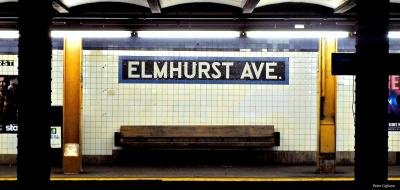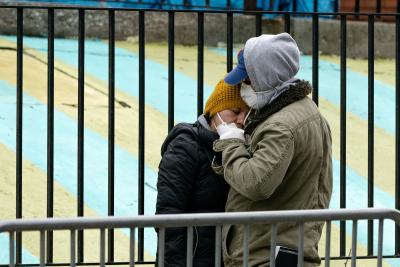Hotbeds of Corona
New York City is currently battling the Corona tsunami, giving us images of fancy parts of Manhattan while imagining the horrors of a pandemic on the loose among the dense skyscrapers. That is partly the case, but the newest Corona data for New York City reveals a grim reality. Take the 7-train from midtown Manhattan to its terminus in Queens, and you arrive at the actual current world epicentre of corona – the poor immigrant communities of Elmhurst and Corona.
Take the 7-train from midtown Manhattan to its terminus in Queens, and you arrive at the actual current world epicentre of corona
Elmhurst hospital is seeing an explosive surge in residents heading to the emergency room and is overwhelmed with people lining up outside for tests and treatment – 86 percent of tests come back positive. The hospital has just lined up refrigerated trailers as makeshift morgues for the many dead bodies.
That corona would hit these communities hard was predictable. Yet, with these data we clearly see how pre-existing inequalities in the US create a deadly reality. Thus, New York City holds up a grim mirror to how Corona preys on structural vulnerabilities in poor and racialized communities and what we can expect when Corona begins to travel more rapidly to similar poor communities in the Global South.
The empty 7-train
The 7-train runs almost empty now, but on a normal day, before New York realized Corona was running in its veins, tired immigrant workers would take the 7-train home to Elmhurst after ten-hour shifts in their jobs as restaurant workers, cleaners and dish-washers in Manhattan. Dozing on the orange plastic train seats would also be your take-away delivery guy, nannies and maids, all of them keeping Manhattan alive. New Yorkers depend on the cleaning staff, the subway workers, the cabdrivers and the nannies from places like Elmhurst and Corona. Their migrant labour is the cushion underpinning the US and New York economy. Working in other people’s homes and touching surfaces and doorknobs across the city, they were all at the frontlines of getting Corona and transmitting it to their families and home communities – and they did. It’s real, troubling and highly contagious when a city depends on high numbers of low-paid workers who have to work and commute, but are not able to earn enough to protect themselves.

Queens is the most diverse region of New York City, and where over hundreds of languages are spoken. Many people here migrated to the US to work, yet while employment rates used to be high pre-Corona, they work in low-paying jobs. Immigrant food workers typically earn between $2-$4 an hour before tips and have no health insurance. And they are not necessarily young. Domestic workers are often older than forty, and the average age of a Chinese immigrant food-delivery worker is 46.
Three months before the Corona outbreak, a report stated that ‘Income insecurity in these communities is real and means that the effects of an economic downturn in the future would be widely and harshly felt’. At that time nearly fifty percent were already living below the poverty line. Just three months later Corona hit the community, and 46 percent of New York households reported a job loss. Women (42%) in particular are more affected by job losses than men (29%). When nannies, hotel maids and cleaners are fired, it affects migrant women in particular, while some jobs still remain for migrant men in take-away and grocery stores. When they fall sick they can’t afford to stay home from work, and Manhattan’s wheels can’t turn without them.
The privilege of social distancing
Doctors at Elmhurst hospital describe the difficult conversations they have when hoping to discharge recovered Corona patients from the hospital, as the latter are often homeless or live in apartments that are too overcrowded to permit social distancing. To save money people live in overcrowded apartments more than in other parts of the city, some renting just a single room or caring for elderly relatives. It is difficult if not impossible to conduct social distancing, isolation and quarantine in such communities. It is an unaffordable privilege. As one US social worker said to the local newspaper. ‘No amount of social work can hide what this pandemic lays bare: there is a permanent underclass of people dwelling in our nation’s cities who have no way to safely comply with the directive to shelter in place and maintain social distance’.
Elmhurst hospital is a public hospital serving everyone, regardless of immigration or insurance status. In Elmhurst and Corona, one in four people lack health insurance. New York City is home to 560,000 undocumented immigrants, many of whom live in Elmhurst and Corona. Yet, there is a gulf between the sort of health care an undocumented immigrant and a native-born well-insured American can access. When the people in Elmhurst need emergency Corona care, they have to go to a hospital that is already overwhelmed, lacking beds, ventilators and protective gear.

The Corona Architecture
The spread of Corona seems to present a global image of our connectedness, interdependencies and inequalities. It sprang from poor market-traders in densely populated areas of China, and then travelled with the globally privileged via airplanes, business and tourism – especially via skiing resorts in Italy and Austria and on cruise ships – before now dispersing into poor neighbourhoods in New York and other disenfranchised places. There is a ‘corona architecture’ at play here that mimics the economic structures of our globalized present.
Corona is fuelled by inequality, and this exact same pattern is on its way to hit thousands of communities in the Global South
What we are witnessing in Elmhurst shows in detail how Corona travels along already established routes, but enters in the most devastating ways through the social cracks left by unemployment, bad housing and health care. Corona is fuelled by inequality, and this exact same pattern is on its way to hit thousands of communities in the Global South.
Senior Researcher Sine Plambech is currently a Guest Professor at Yale University. She has previously lived and worked in New York City andcomments on the situation of Corona in the US for DIIS.
DIIS Experts

